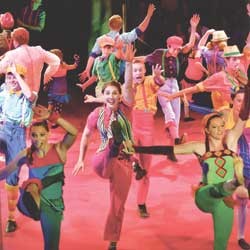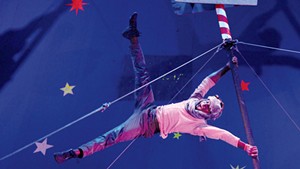
Nothing can duplicate the breathless energy of a circus, with its aerial feats, precision jugglers and rambunctious clowns. But the book Circus Smirkus gives it a go, and its many photographs of exuberant, plucky children nearly vibrate with excitement. Subtitled 25 Years of Running Home to the Circus!, the new volume tells, of course, the story of Greensboro-based Circus Smirkus, starting with that of founder Rob Mermin. And the story evokes all the superlatives — Amazing! Incredible! — that big-top promoters have employed for more than a hundred years.
Written by Mermin and Norwich writer Rob Gurwitt, Circus Smirkus is presented in the alternating voices of the two Robs — first person and third — interspersed with oh-by-the-way sidebars, stand-alone quotes and additional memories from participants, including executive director Ed LeClair. This approach, and the lively layout and typography by Serena Fox Design Company of Waitsfield, give the narrative an air of having “acts” and “sideshows” rather than plain old chapters. It can be a little distracting, but that’s OK; you can read for a bit, stop and look at the pictures or check out a sidebar on, say, how the circus got its name, or even skip ahead. Though the story flows in chronological order, it seems to invite readers to jump in anywhere.
If you were to read from front to back, you’d learn first how Mermin “ran away” from Vermont to Europe to learn the circus arts; how, after more than a decade of exhilarating fun, grueling work and extraordinary training — including with the master mime artist Marcel Marceau in France — he returned to Greensboro, bought an old farm with a barn and started a children’s circus; and then how that venture evolved over a quarter-century.
One of the most basic questions a reader may have is, Why a circus with kids? Here’s how Mermin answers it:
I was very impressed by the maturity of the children of professional circus artists I worked with in Europe. Growing up in the world of circus seemed to impart an education in life missing from normal schooling. Circus kids understood geography and spoke several languages by necessity. Tolerance of other cultures was ingrained. Every day featured hard work, self-reliance, communal living and close-knit family life. I wanted to give American kids a taste of the same experiences.
And so he did — not just to Vermonters but to children from 26 states and 32 countries.
The book does not shy away from relating difficulties that Mermin and Circus Smirkus endured over the years, from the serious — including near-bankruptcy — to the quotidian, as this opening to a chapter titled “Another Fine Mess” reveals:
It’s 2008. Already on this tour, Troy has driven a stake through a town water line. The pie car has come unhitched and passed the truck that was pulling it — on the interstate. A new rental generator has fried all the lights in the tent.
No mishap was as dire, however, as the tragic accident described in the chapter called simply “Marÿn.” A circus enthusiast and counselor from Holland, Marÿn van der Vaart quickly won not only the affections of the Smirkus kids in the summer of 1989, but the heart of ringleader Rob Mermin. After an afternoon swim at a nearby lake, the two conversed about their future together, Mermin writes, and then got into their car. Rob Gurwitt picks up the story:
Headed back to the Barn, Marÿn was driving, Rob and Rufus were in the passenger seat. On a washed-out part of the dirt road, the car suddenly veered off into a tree. Marÿn was killed instantly; Rufus appeared dead and Rob was lying in the road, his life dangling by a thread.
Despite serious injuries, including a broken neck — and a broken heart — Mermin obviously survived, as did his beloved dog, Rufus. As both lay in hospitals that day, the young troupers made a brave decision that troupers always do: The show must go on. This time, for Marÿn.
For all the blood, sweat, tears and mud in the story of Circus Smirkus, tales of joy, determination, accomplishment and victory more than compensate. One fascinating chapter details an evolutionary leap: With “the advent of the Russians” — professional circus coaches — the kids’ delight in performance began to be balanced with “athleticism and technical ambition,” writes Gurwitt. Circus Smirkus, and Greensboro, Vt., were changed forever.
It’s not just a commemorative book that has marked the past year in the life of Circus Smirkus. Students from the National Circus School of Cuba are performing in this year’s tour, called “Topsy-Turvy Time Travel.” It is the first U.S./Cuba youth circus cultural exchange. Vermont filmmaker Signe Taylor’s 2011 documentary about the troupe, Circus Dreams, is airing on public television stations around the country. Not least, another generation of youngsters has run away to the circus, every one finding skills, strength and confidence they didn’t know they had. And having big-top-size fun.
“People always expect me to use circus metaphors, but personally I think Smirkus is like watching a child grow,” writes LeClair. “On the one hand it’s the most ordinary thing in the world; on the other, it’s a miracle.”











Comments
Comments are closed.
From 2014-2020, Seven Days allowed readers to comment on all stories posted on our website. While we've appreciated the suggestions and insights, right now Seven Days is prioritizing our core mission — producing high-quality, responsible local journalism — over moderating online debates between readers.
To criticize, correct or praise our reporting, please send us a letter to the editor or send us a tip. We’ll check it out and report the results.
Online comments may return when we have better tech tools for managing them. Thanks for reading.